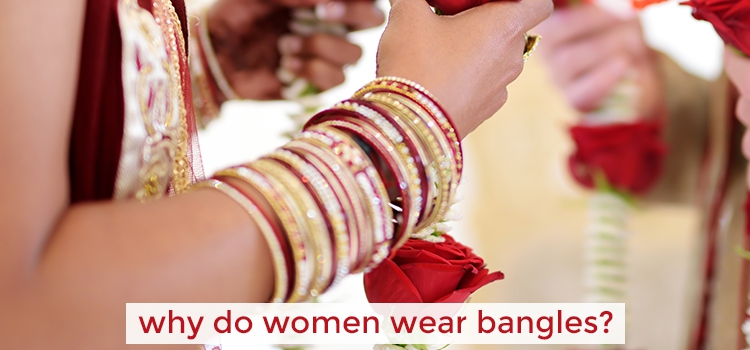Why do Women Wear Bangles?
Bangle' is a word that is derived from the Sanskrit word, ‘Bangri’ or ‘Bangali’. It means ornaments that decorate the arms. In India, women love to wear bangles of many colors to add beauty to their arms. Bangles are made of different kinds of materials like glass, conch, wood, ivory, and metals like gold, silver, copper, etc. Since ancient times, Indian women have worn bangles. Even the scriptures mention that women wore bangles. At times, they wore bangles fashioned from flowers and terracotta, too.
Both excavations and cave paintings from the early periods depict both men and women wearing ornaments. Indian literature has many descriptions of women adorning themselves with jewelry. Shringar rasa is an important theme in Indian classical dance forms.

Evidence from a female figurine discovered at an archeological site containing artifacts from the Mohenjo Daro civilization suggests that women of that period used to wear bangles. The woman’s one arm rests on her hip, and the other has many bangles on it. The objects collected from such sites indicate that stones, shells, and terracotta were used to make bangles in those days. Figures of Yakshinis or female spirits were also recovered, and these, too, had bangles on their arms. Banabhatta’s Kadamalari has a reference to Goddess Saraswati wearing Kangan or bangles.
The Vedic Concept of Solah Shringar
Ancient Vedic texts talk about ‘Solah Shringar’ (16 embellishments), which means that a woman should adorn herself with sixteen embellishments. These include the bindi, earrings, necklaces, flowers in the hair, finger rings, armlets, bangles, waistbands, ankle-bells, toe-rings, kajal, henna, sandalwood paste, perfume, the upper garment, and lower garment. However, modern Indian women do not use many of these for practical reasons.
The texts also claim that the use of Solah Shringar has a scientific basis. Many of the 16 embellishments can boost the wearer’s good health and well-being. Hindus believe that women represent the divine female principle or Shakti. So in Hindu tradition, ornaments are worn in order to protect orifices and extremities. They help to control the power that emanates from these body parts.
For instance, women who get their nose pierced to wear a nose ring supposedly experience less pain during childbirth. Bangles can increase a woman’s blood circulation and prevent the cosmic energy passing through her body from leaving the body. Toe rings can help regularize the menstrual cycle. The belief is that the nerves in the second toe, where the rings are worn, are connected to the uterus. The friction caused by the rings helps to revitalize the reproductive organs. Necklaces, including the mangalsutra, can control blood pressure levels and improve blood circulation. Waistbands supposedly prevent fat from accumulating in the waist and help to maintain a woman’s figure.
The Vedic texts talk about the significance of wearing bangles. Supposedly, the sound waves they created could energize the motor organs. Let us see what are the benefits of wearing bangles. The sound waves emitted by glass bangles can increase the sattvik components.
A person’s Kriya shakti or energy of action increases if they wear bangles. Kriya Shakti is present around our bodies. It can help in avoiding negative energies. Bangles help to boost the Divine energy principle or Shakti Tattva. The sound waves help to purify the woman’s body. When the bangles move on the woman’s wrist, it enhances the Raja component. This can increase the Adishakti Tattva or the Primal Energy principle.
The benefits enumerated above are all mentioned in the Vedic scriptures. It is amazing to think that the ancient sages knew so much about the human body and how it responds to various stimuli.
Importance of Wearing Bangles
Both married and unmarried women wear bangles. In India, it is believed that not wearing bangles can attract negative energies. In some rural areas, people even see it as a bad omen. Gold and glass bangles are traditionally preferred by women. Supposedly, wearing glass bangles is good for the well-being of the husband and sons. It also indicates that a woman is married. There is both a religious as well as scientific angle to wearing bangles.
Women usually did not have to do hard labor like men. As the work they did was not involve a lot of intense physical activity, there was a chance that they would have high blood pressure. When bangles are worn on the wrist, they cause some friction which boosts blood circulation. The women would also feel less anger and impatience.
Bangles are circular in shape. This means that the positive energy that flows through the woman’s body will not escape from the body. So the bangles help to recharge vitality.
There is a ceremony among Hindus where women who are seven months pregnant are given glass bangles to wear on their arms. This is because the sound waves created by the tinkling bangles stimulate the baby’s brain cells and help them to develop. At seven months, the embryo can recognize sounds. Also, it helps to calm the woman and reduce her stress.
The vibrations caused by the bangles help to moderate emotions and induce positivity. Women who do not wear bangles tend to be very emotional. Glass bangles can absorb positive energy and repel negative energy. They help purify the surroundings.
The colors of the bangles are also significant. Red bangles bring positive energy. White bangles signify new beginnings. Yellow bangles evoke happiness. Green bangles bring good luck and prosperity. Black bangles signify power. Purple bangles represent freedom. Blue bangles signify wisdom. Gold bangles bring good fortune, and silver bangles provide strength and protection.
The number of bangles is also relevant. The bangles can generate both Marak and Tarak shakti. Three bangles create Tarak shakti, while six bangles create Tarak-Marak shakti. Eight bangles create Marak-Tarak shakti, while 12 bangles create Marak shakti.



















